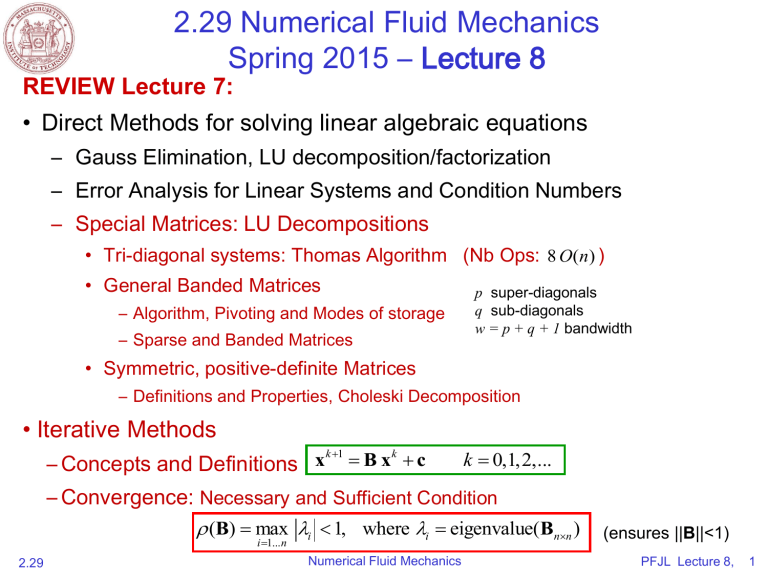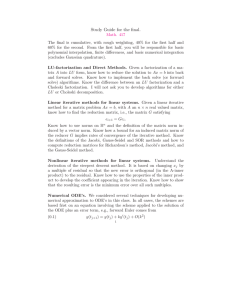2.29 Numerical Fluid Mechanics Spring 2015 – Lecture 8 REVIEW Lecture 7:

2.29 Numerical Fluid Mechanics
Spring 2015 – Lecture 8
REVIEW Lecture 7:
• Direct Methods for solving linear algebraic equations
– Gauss Elimination, LU decomposition/factorization
– Error Analysis for Linear Systems and Condition Numbers
– Special Matrices: LU Decompositions
• Tri-diagonal systems: Thomas Algorithm (Nb Ops: )
• General Banded Matrices
– Algorithm, Pivoting and Modes of storage
– Sparse and Banded Matrices p super-diagonals q sub-diagonals w = p + q + 1 bandwidth
• Symmetric, positive-definite Matrices
– Definitions and Properties, Choleski Decomposition
• Iterative Methods
– Concepts and Definitions x k 1
B x k c k 0,1,2,...
2.29
– Convergence: Necessary and Sufficient Condition
i 1...
n
i
1, where i
eigenvalue(
B
)
Numerical Fluid Mechanics
(ensures ||
B
||<1)
PFJL Lecture 8, 1
TODAY (Lecture 8): Systems of Linear Equations IV
2.29
• Direct Methods
– Gauss Elimination
– LU decomposition/factorization
– Error Analysis for Linear Systems
– Special Matrices: LU Decompositions
• Iterative Methods
– Concepts, Definitions, Convergence and Error Estimation
– Jacobi’s method
– Gauss-Seidel iteration
– Stop Criteria
– Example
– Successive Over-Relaxation Methods
– Gradient Methods and Krylov Subspace Methods
– Preconditioning of
Ax
= b
Numerical Fluid Mechanics PFJL Lecture 8, 2
Reading Assignment
• Chapters 11 of Chapra and Canale, Numerical Methods for
Engineers, 2006/2010/2014.”
– Any chapter on “Solving linear systems of equations” in references on
CFD references provided. For example: chapter 5 of “J. H. Ferziger and M. Peric, Computational Methods for Fluid Dynamics. Springer,
NY, 3 rd edition, 2002”
• Chapter 14.2 on “Gradient Methods” of Chapra and Canale,
Numerical Methods for Engineers, 2006/2010/2014.”
– Any chapter on iterative and gradient methods for solving linear systems, e.g. chapter 7 of
Ascher and Greif, SIAM, 2011.
Numerical Fluid Mechanics PFJL Lecture 8, 3 2.29
Linear Systems of Equations: Iterative Methods
Error Estimation and Stop Criterion
Express error as a function of latest increment:
( if
B
1 )
If we define
= || B || <1, it is only if
<= 0.5 that it is adequate to stop the iteration when the last relative error is smaller than the tolerance (if not, actual errors can be larger)
2.29
Numerical Fluid Mechanics PFJL Lecture 8, 4
2.29
Linear Systems of Equations: Iterative Methods
General Case and Stop Criteria
• General Formula
Ax e x i 1
i i
b i 1,2,.....
• Numerical convergence stops: i n max x i
x i 1 r i
r i 1
, where r i
Ax i
b r i
(if x i not normalized, use relative versions of the above)
Numerical Fluid Mechanics PFJL Lecture 8, 5
2.29
Linear Systems of Equations: Iterative Methods
Element-by-Element Form of the Equations
0
0 x x
0 x x
0 x x
0
0 x
0 x x
0
0 x
Sparse (large) Full-bandwidth Systems (frequent in practice)
Iterative Methods are then efficient
Analogous to iterative methods obtained for roots of equations, i.e. Open Methods: Fixed-point, Newton-Raphson, Secant
Rewrite Equations
0
0
0
0
0
0
Note: each x i is a scalar here, the i th element of x
Numerical Fluid Mechanics PFJL Lecture 8, 6
Iterative Methods: Jacobi and Gauss Seidel
Rewrite Equations:
Sparse, Full-bandwidth
Systems
0
0 x x x x
0
0 x x
0 x
0
0 x x
0
0 x
=> Iterative, Recursive Methods:
Jacobi’s Method
0
0
0
Computes a full new x based on full old x , i.e.
Each new x i is computed based on all old x i
’s
GaussSeidel’s Method
0
0
0
2.29
New x based most recent x 1 x x elements, i.e.
Numerical Fluid Mechanics x i k 1
PFJL Lecture 8, 7
Iterative Methods: Jacobi’s Matrix form
Iteration
– Matrix form
Jacobi’s Method
Decompose Coefficient Matrix with
= -
Iteration
Matrix form
= -
Note: this is NOT
LU-factorization
Numerical Fluid Mechanics 2.29
PFJL Lecture 8, 8
Convergence of Jacobi and Gauss-Seidel
• Jacobi:
A x
b
D x
(L
U) x
b x k 1 -
D (L
U) x k
D b
2.29
• Gauss-Seidel:
A x x k 1
b
(
D
)
U x
b
D L x k 1
D U x k
D b x k 1 (
D
L
) -1
U x k (
D
L
) -1 b or
• Both converge if
A strictly diagonal dominant
• Gauss-Seidel also convergent if
A symmetric positive definite matrix
• Also Jacobi convergent for
A if
–
A symmetric and {
D, D + L + U, D - L - U
} are all positive definite
Numerical Fluid Mechanics PFJL Lecture 8, 9
2.29
Sufficient Condition for Convergence
Proof for Jacobi
A x
b
D x
(L
U) x
b x k 1 -
D (L
U) x k
D b
Sufficient Convergence Condition
Jacobi’s Method
Using the
∞
-Norm
(Maximum Row Sum)
Hence, Sufficient Convergence Condition is:
Strict Diagonal Dominance
Numerical Fluid Mechanics PFJL Lecture 8, 10
x
2
Illustration of
Convergence (left) and Divergence (right) of the Gauss-Seidel Method x
2 v v
2.29
u x
1 x
1 u
(A) (B)
Illustration of (A) convergence and (B) divergence of the Gauss-Seidel method.
Notice that the same functions are plotted in both cases (u:11x1+13x2=286; v:11x1-9x2=99).
Image by MIT OpenCourseWare.
Numerical Fluid Mechanics PFJL Lecture 8, 11
Special Matrices: Tri-diagonal Systems
Example “Forced Vibration of a String”
Finite Difference Differential Equation:
Boundary Conditions:
Discrete Difference Equations
+
Matrix Form y
Strict Diagonal Dominance?
kh 2 h
2 k
Tridiagonal Matrix
For Jacobi, recall that a sufficient condition for convergence is: n n
With B=-D -1 (L+U)
: If a ii
j 1, a ij
B
max ( i 1...
n j
1 b ij
) max ( i 1...
n j n
1, a ij a ii
Numerical Fluid Mechanics 2.29
PFJL Lecture 8, 12
2.29
vib_string.m (Part I)
n=99;
L=1.0; h=L/(n+1); k=2*pi; kh=k*h
%Tri-Diagonal Linear System: Ax=b x=[h:h:L-h]'; a=zeros(n,n); f=zeros(n,1);
% Offdiagonal values o=1.0
a(1,1) =kh^2 - 2; a(1,2)=o; for i=2:n-1 a(i,i)=a(1,1); a(i,i-1) = o; a(i,i+1) = o; end a(n,n)=a(1,1); a(n,n-1)=o;
% Hanning window load nf=round((n+1)/3); nw=round((n+1)/6); nw=min(min(nw,nf-1),n-nf); figure(1) hold off
% Exact solution y=inv(a)*f; subplot(2,1,2); p=plot(x,y, 'b' );set(p, 'LineWidth' ,2); p=legend([ 'Off-diag. = ' num2str(o)]); set(p, 'FontSize' ,14); p=title( 'String Displacement (Exact)' ); set(p, 'FontSize' ,14); p=xlabel( 'x' ); set(p, 'FontSize' ,14); nw1=nf-nw; nw2=nf+nw; f(nw1:nw2) = h^2*hanning(nw2-nw1+1); subplot(2,1,1); p=plot(x,f, 'r' );set(p, 'LineWidth' ,2); p=title( 'Force Distribution' ); set(p, 'FontSize' ,14)
Numerical Fluid Mechanics PFJL Lecture 8, 13
2.29
vib_string.m (Part II)
%Iterative solution using Jacobi's and Gauss-Seidel's methods b=-a; c=zeros(n,1); for i=1:n b(i,i)=0; for j=1:n b(i,j)=b(i,j)/a(i,i); c(i)=f(i)/a(i,i); end end nj=100; xj=f; xgs=f; figure(2) nc=6 col=[ 'r' 'g' 'b' 'c' 'm' 'y' ] hold off for j=1:nj
% jacobi xj=b*xj+c;
% gauss-seidel xgs(1)=b(1,2:n)*xgs(2:n) + c(1); for i=2:n-1 xgs(i)=b(i,1:i-1)*xgs(1:i-1) + b(i,i+1:n)*xgs(i+1:n) +c(i); end xgs(n)= b(n,1:n-1)*xgs(1:n-1) +c(n); cc=col(mod(j-1,nc)+1); subplot(2,1,1); plot(x,xj,cc); hold on ; p=title( 'Jacobi' ); set(p, 'FontSize' ,14); subplot(2,1,2); plot(x,xgs,cc); hold on ; p=title( 'Gauss-Seidel' ); set(p, 'FontSize' ,14); p=xlabel( 'x' ); set(p, 'FontSize' ,14); end
Numerical Fluid Mechanics PFJL Lecture 8, 14
vib_string.m
o=1.0, , k=2*pi, h=.01, kh<2
Exact Solution Iterative Solutions
2.29
Coefficient Matrix Not Strictly Diagonally Dominant
Numerical Fluid Mechanics PFJL Lecture 8, 15
vib_string.m
o=1.0, , k=2*pi*31, h=.01, kh<2
Exact Solution Iterative Solutions
2.29
Coefficient Matrix Not Strictly Diagonally Dominant
Numerical Fluid Mechanics PFJL Lecture 8, 16
vib_string.m
o=1.0, k=2*pi*33, h=.01, kh>2
Exact Solution Iterative Solutions
2.29
Coefficient Matrix Strictly Diagonally Dominant
Numerical Fluid Mechanics PFJL Lecture 8, 17
vib_string.m
o=1.0, k=2*pi*50, h=.01, kh>2
Exact Solution Iterative Solutions
2.29
Coefficient Matrix Strictly Diagonally Dominant
Numerical Fluid Mechanics PFJL Lecture 8, 18
vib_string.m
o = 0.5, k=2*pi, h=.01
Exact Solution Iterative Solutions
2.29
Coefficient Matrix Strictly Diagonally Dominant
Numerical Fluid Mechanics PFJL Lecture 8, 19
Successive Over-relaxation (SOR) Method
• Aims to reduce the spectral radius of B to increase rate of convergence
• Add an extrapolation to each step of Gauss-Seidel x i k 1 x i k 1 (1 ) , where x i k 1
1
0
SOR Gauss-Seidel
2 Over-relaxation (weight new values more)
• If “A” symmetric and positive definite converges for 0
• Matrix format: x k 1 (
D
L
) [
U
(1
D x k (
D
L
) 1 b
2
• Hard to find optimal value of over-relaxation parameter for fast convergence (aim to minimize spectral radius of
B
) because it depends on BCs, etc.
opt
?
2.29
Numerical Fluid Mechanics PFJL Lecture 8, 20
Gradient Methods
• Prior iterative schemes (Jacobi, GS, SOR) were “stationary” methods (iterative matrices B remained fixed throughout iteration)
• Gradient methods:
– utilize gathered information throughout iterations (i.e. improve estimate of the inverse along the way)
– Applicable to physically important matrices: “symmetric and positive definite” ones
• Construct the equivalent optimization problem
1
2
T dx
Ax b dx x opt
0 x opt
e
, e
b
• Propose step rule search direction at iteration i + 1 x i 1 x i
v
• Common methods
– Steepest descent step size at iteration i + 1
– Conjugate gradient
• Note: above step rule includes iterative “stationary” methods (Jacobi, GS, SOR, etc.)
2.29
Numerical Fluid Mechanics PFJL Lecture 8, 21
2.29
Steepest Descent Method
• Move exactly in the negative direction of the Gradient dQ ( x )
Ax b ( b Ax ) r dx r : residual , r i
b Ax i y
• Step rule (obtained in lecture) x i 1
x i
r i
T r i
T r i
Ar i r i
1
2
0 x
Image by MIT OpenCourseWare.
Graph showing the steepest descent method.
• Q(x) reduces in each step, but slow and not as effective as conjugate gradient method
Numerical Fluid Mechanics PFJL Lecture 8, 22
Conjugate Gradient Method
Derivation provided in lecture
Check CGM_new.m
• Definition: “A-conjugate vectors” or “Orthogonality with respect to a matrix (metric)”: if
A is symmetric & positive definite,
For v v j
A v i
T
A v j
0
• Proposed in 1952 (Hestenes/Stiefel) so that directions v i are generated by the orthogonalization of residuum vectors (search directions are
A
-conjugate)
– Choose new descent direction as different as possible from old ones, within A
-metric
• Algorithm:
Step length
Approximate solution
New Residual
Step length & new search direction
Figure indicates solution obtained using
Conjugate gradient method (red) and
Note: A v i
2.29
= one matrix vector multiply at each iteration
Numerical Fluid Mechanics steepest descent method (green) .
PFJL Lecture 8, 23
MIT OpenCourseWare http://ocw.mit.edu
2 .29 Numerical Fluid Mechanics
Spring 20 1 5
For information about citing these materials or our Terms of Use, visit: http://ocw.mit.edu/terms .



